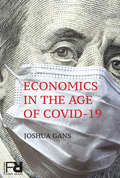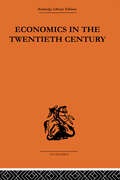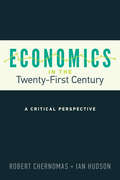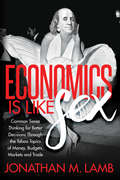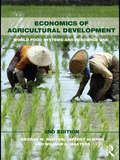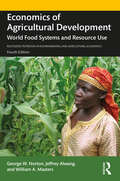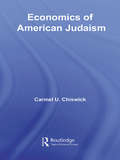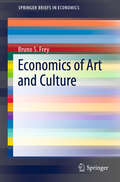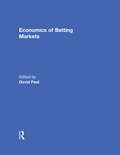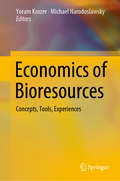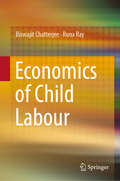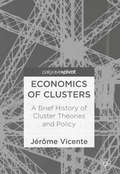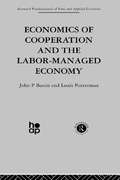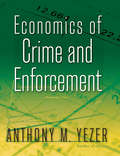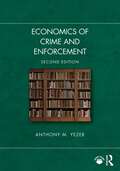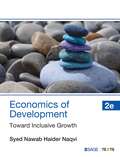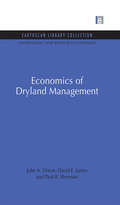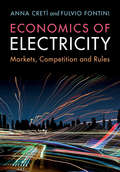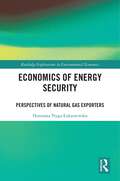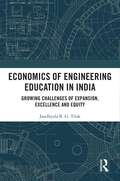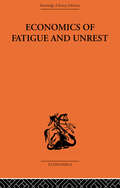- Table View
- List View
Economics in the Age of COVID-19 (MIT Press First Reads)
by Joshua GansA guide to the pandemic economy: essential reading about the long-term implications of our current crisis.The COVID-19 pandemic has unleashed a firehose of information (much of it wrong) and an avalanche of opinions (many of them ill-founded). Most of us are so distracted by the everyday awfulness that we don't see the broader issues in play. In this book, economist Joshua Gans steps back from the short-term chaos to take a clear and systematic look at how economic choices are being made in response to COVID-19. He shows that containing the virus and pausing the economy—without letting businesses fail and people lose their jobs—are the necessary first steps.
Economics in the Twentieth Century: The History of its International Development
by Theo Suranyi-UngerThis book discusses the history of economic theories, drawing largely from periodical literature, which is often hard to obtain. The book is divided into sections along linguistic lines (German, Romance and English speaking countries).
Economics in the Twenty-First Century: A Critical Perspective
by Ian Hudson Robert ChernomasEconomics has always been nicknamed the "dismal science," but today the field seems a little more dismal than usual as governments, social movements, and even students complain that the discipline is failing to make sense of the major economic problems of the day.In Economics in the Twenty-First Century, Robert Chernomas and Ian Hudson demonstrate how today's top young economists continue to lead the field in the wrong direction. The recent winners of the John Bates Clark medal, economics's "baby Nobel," have won that award for studying important issues such as economic development, income inequality, crime, and health. Examining their research, Chernomas and Hudson show that this work focuses on individual choice, ignores the systematic role of power in the economic system, and leads to solutions that are of limited effectiveness at best and harmful at worst.An accessible summary of the latest debates in economics, Economics in the Twenty-First Century takes on what is missing from mainstream economics, why it matters, and how the discipline can better address the key concerns of our era.
Economics is Like Sex: Common Sense Thinking for Better Decisions Through the Taboo Topics of Money, Budgets, Markets and Trade
by Jonathan M. LambEconomics has become a taboo topic because is not well understood. As a taboo topic it doesn&’t get discussed, and since it is not discussed, it is not understood—what a vicious cycle!Shying away from open discussions about money, budgets, markets, and trade has resulted in many misconceptions. Economics is all around us, and with a little common sense understanding of economic principals, Jonathan M. Lamb changes the way people view the world. Economics is Like Sex advocates that economics isn&’t a boring subject filled with charts and theories cooked up by some dead guys who lived centuries ago. Economics is about decisions. Decisions that relate to money, life, love, and happiness. Economics is not just for government and business, but is a way of everyday life, and some very simple economic thinking can make life just a little bit less complicated when it comes to money.Money can&’t buy love or happiness, but Jonathan Lamb opens the taboo topic to provide a common sense understanding of how basic, easy, common sense economic principals can change the way people view the world.
Economics of Agglomeration, Second Edition
by Masahisa Fujita Jacques-François ThisseEconomic activities are not concentrated on the head of a pin, nor are they spread evenly over a featureless plane. On the contrary, they are distributed very unequally across locations, regions, and countries. Even though economic activities are, to some extent, spatially concentrated because of natural features, economic mechanisms that rely on the trade-off between various forms of increasing returns and different types of mobility costs are more fundamental. This book is a study of the economic reasons for the existence of a large variety of agglomerations arising from the global to the local. This second edition combines a comprehensive analysis of the fundamentals of spatial economics and an in-depth discussion of the most recent theoretical developments in new economic geography and urban economics. It aims to highlight several of the major economic trends observed in modern societies.
Economics of Agricultural Development: 2nd Edition (Routledge Textbooks in Environmental and Agricultural Economics)
by William A. Masters Jeffrey Alwang George W. NortonThe globalization of goods, services and capital for agriculture is fundamental to the future of developing countries and has major implications for the fight against poverty and sustainability of the environment. In recent years, agriculture has once again returned to a position of centre stage as food price volatility has led countries to re-examine their development strategies. This new edition of the essential textbook in the field builds on the 2006 original and reflects the following developments: the increased impact of climate change issues affecting agricultural markets such as bio-fuels, the rise in farm prices and energy costs the move to higher valued agricultural products The book contains a wealth of real world case studies and is now accompanied by a website that includes powerpoint lectures, a photo bank and a large set of discussion and exam questions.The accompanying website is available to view at http://ecagdev.agecon.vt.edu/
Economics of Agricultural Development: World Food Systems and Resource Use (Routledge Textbooks in Environmental and Agricultural Economics)
by William A. Masters Jeffrey Alwang George W. NortonEconomics of Agricultural Development examines the causes, severity, and effects of poverty, population growth, and malnutrition in developing countries. It discusses potential solutions to these problems, progress made in many countries in recent years, and the implications of globalization for agriculture, poverty, and the environment. Topics covered in the book include: * Means for utilizing agricultural surpluses to further overall economic development * The sustainability of the natural resource environment * Gender issues in relation to agriculture and resource use * The contribution of agricultural technologies * The importance of agricultural and macroeconomic policies as related to development and trade, and the successes and failures of such policies * Actions to encourage more rapid agricultural and economic development The globalization of trade in goods, services, and capital has been fundamental to changes being experienced in the agricultural and rural sectors of developing countries. It has major implications for the fight against poverty and food insecurity and for environmental sustainability. Recently, agriculture has returned to a position of center stage in the development dialog as food price volatility has increased along with water scarcity, and concerns grow over the effects of climate change on food supply and food security. This new edition of the essential textbook in the field builds on the 2010 edition and reflects the following developments: * Growth in foreign demand for land and other natural resources * Significant progress in agricultural and economic development in some low-income countries while others are being left behind * Continued growth in demand for higher-valued farm products This book is essential reading for undergraduate students seeking to understand the economics of agricultural development and the world food system, including environmental and human consequences, international trade, and capital flows. This book contains a wealth of real world case studies, and is accompanied by a website that includes powerpoint lectures, a photo bank, and a large set of discussion and exam questions at http://ecagdev.agecon.vt.edu/.
Economics of Agricultural Development: World Food Systems and Resource Use (Routledge Textbooks in Environmental and Agricultural Economics)
by William A. Masters Jeffrey Alwang George W. NortonEconomics of Agricultural Development examines the causes, severity, and effects of poverty, population growth, and malnutrition in developing countries. It discusses potential solutions to these problems, progress made in many countries in recent years, and the implications of globalization for agriculture, poverty, and the environment. Topics covered in the book include: Means for utilizing agricultural surpluses to further overall economic development The sustainability of the natural resource environment Gender issues in relation to agriculture and resource use The contribution of improved technologies to agricultural development The importance of agricultural policies and institutions to development and trade Actions to encourage more rapid agricultural and economic development This new edition reflects the following developments: Growth in environmental challenges due to climate change Continued progress in agricultural and economic development in many low-income countries while other countries and regions are being left behind Continued growth in demand for higher-valued farm products This book is essential reading for undergraduate students seeking to understand the economics of agricultural development and the world food system, including environmental and human consequences, international trade, and capital flows. It contains a wealth of real-world case studies and is accompanied by a website.
Economics of American Judaism (Routledge Frontiers Of Political Economy Ser.)
by Carmel ChiswickThis book collects in one readily-accessible volume the pioneering research of Carmel U. Chiswick on the Economics of American Judaism. Filling a major gap in the social-scientific literature, Chiswick‘s economic perspective complements that of other social scientists and historians. She demonstrates clearly that economic analysis can deepen our un
Economics of Art and Culture (SpringerBriefs in Economics)
by Bruno S. FreyThis book studies the relationship between the arts and the economy. By applying economic thinking to arts and culture, it analyses markets for art and cultural goods, highlights specific facets of art auctions and discusses determinants of the economic success of artists. The author also sheds new light on various cultural areas, such as the performing and visual arts, festivals, films, museums and cultural heritage. Lastly, the book discusses cultural policies, the role of the state in financing culture, and the relationship between the arts and happiness.
Economics of Betting Markets
by David PeelDuring the last few decades, commercial gambling has increased substantially throughout the Western world. More people than ever before have access to sources of legalised gambling, leading to bumper revenues for the institutions involved. Naturally enough, this has led to an increased interest in the area of the economics of betting.This book addresses the issues raised by the continued growth of the gambling sector. How can we model the behaviour of people who seemingly act irrationally? What are the implications of different tax policies with regard to gambling? Are casinos capable of taking money away from state-run lotteries and the causes they fund? Can bookmakers’ odds be influenced in such a way as to make the gambling market inefficient? The authors in this volume provide insights based on data from many different countries, including England, the USA, Australia, Spain and Cyprus. This volume brings together work which addresses the economic impact of the huge growth of commercial gambling in the Western world, as well as trying to model the cognitive processes which can explain why individuals are prepared to behave in such apparently irrational ways.This book was published as a special issue of Applied Economics. The academic editor of this journal is Mark P. Taylor.
Economics of Bioresources: Concepts, Tools, Experiences
by Yoram Krozer Michael NarodoslawskyThis fundamental book provides a cross-sectoral, multi-disciplinary view on the biobased economy. It explains opportunities for the value-adding production and use of bioresources, while also discussing the main drivers and obstacles involved. The book is divided into three major parts, the first of which introduces readers to the basics of bioresource economics and engineering. In terms of economics, it discusses decision-making from the policy, producer, investor, and citizen perspectives; in terms of engineering, it addresses key technologies and the processing of bioresources, as well as the development of biorefineries for high-value products on large and small scales. In turn, the book’s second part presents cases focused on different types of energy use, and written by practitioners. The cases illustrate the businesses and technologies involved, as well as the roles of citizens, social organisations and policies. The book’s third and last part highlights opportunities in sustainable agriculture, valuable industrial products and innovative services, while also outlining key conditions for success. Written by a team of scholars and practitioners from various engineering, natural-science and social-science disciplines, the book is primarily intended for undergraduate and graduate students, and for practitioners in business and policy who wish to explore the sustainable production and use of bioresources. All theoretical issues are explained with the aid of real-world examples, making the content highly accessible.
Economics of Business Valuation
by Patrick L. AndersonFor decades, the market, asset, and income approaches to business valuation have taken center stage in the assessment of the firm. This book brings to light an expanded valuation toolkit, consisting of nine well-defined valuation principles hailing from the fields of economics, finance, accounting, taxation, and management. It ultimately argues that the "value functional" approach to business valuation avoids most of the shortcomings of its competitors, and more correctly matches the actual motivations and information set held by stakeholders. Much of what we know about corporate finance and mathematical finance derives from a narrow subset of firms: publicly traded corporations. The value functional approach can be readily applied to both large firms and companies that do not issue publicly traded stocks and bonds, cannot borrow without constraints, and often rely upon entrepreneurs to both finance and manage their operations. With historical side notes from an international set of sources and real-world exemplars that run throughout the text, this book is a future-facing resource for scholars in economics and finance, as well as the academically minded valuation practitioner.
Economics of Child Labour
by Biswajit Chatterjee Runa RayThis book examines the effectiveness of trade and non-trade policies to combat the menace of child labour. Although it has decreased on the global scale in recent years, child labour still remains high, particularly in the developing countries. Keeping in mind the estimated extent of child labour in different regions around the globe, the book offers a detailed critical review of both theoretical and empirical literature on the topic as well as the policies to reduce the incidence of child labour. It also develops a general equilibrium model to demonstrate the possible effects of growth-promoting, non-trade policies, as opposed to direct trade policies, on child labour employment mitigation. The book argues that of the non-trade policies, the introduction of compulsory education appears to be an effective instrument for curtailing the child labour problem when families receive targeted subsidies for sending their children to school. It also shows that appropriately designed and targeted education subsidies can reduce the incidence of child labour and that social protection measures, such as subsidies on school enrolment, also tend to have a positive impact. The book not only opens up research topics for academicians but is also a valuable resource for policy makers.
Economics of Clusters: A Brief History of Cluster Theories and Policy
by Jérôme VicenteWhen we talk about clusters, it's the fabulous destiny of Silicon Valley that first comes to mind – the place where entrepreneurs and policymakers alike flock. But do we really understand the complex mechanics of these clusters? What tools can economics and other related disciplines use to analyze their performance? When it comes to spending taxpayer money to support cluster development, do benefits actually exceed costs? This book provides a synthesis of cluster theory and presents methodologies to analyze their structure and performance. It also contains insights into how to renew regional innovation policy.The French edition of this volume was granted Best Book in Economics 2016 by The French Association of Economics (AFSE)
Economics of Cooperation and the Labour-Managed Economy
by J. Bonin L. PuttermanDiscusses the theory of labour-managed firms or producers' cooperatives, and of economies companies principally of such firms.
Economics of Crime and Enforcement
by Anthony M. YezerThis text is designed for use in a course on the economics of crime in a variety of settings. Assuming only a previous course in basic microeconomics, this innovative book is strongly linked to the new theoretical and empirical journal literature. Showing the power of microeconomics in action, Yezer covers a wide array of topics. There are chapters on the following topics: benefit-cost and the imprisonment decision, enforcement games, juvenile crime, private enforcement, economics of 3 strikes law, broken windows strategies, police profiling, and crime in developing countries. There are also separate chapters on guns, drugs, and capital punishment. Timely boxed examples are found throughout. Problems at the end of each chapter allow students to reinforce their microeconomics skills and to gain insight into the way they can be applied to case examples.
Economics of Crime and Enforcement
by Anthony M. YezerAssuming only a previous course in basic microeconomics, Economics of Crime and Enforcement is an innovative book which is strongly linked to the new theoretical and empirical journal literature.Showing the power of microeconomics in action, Yezer covers a wide array of topics, including benefit–cost and the imprisonment decision, enforcement games, juvenile crime, private enforcement, economics of three-strikes law, broken windows strategies, police profiling, crime in developing countries, as well as guns, drugs, and capital punishment. This second edition has been fully updated to reflect the latest developments in the field and features new chapters on behavioral economics and crime and crime and large cities. Problem questions provided at the end of each chapter allow students to reinforce their microeconomics skills and gain insight into the way they can be applied to case and application examples.Teaching resources, including PowerPoint slides and answers to problem questions, provide further support for instructors delivering courses on the economics of crime in a variety of settings.
Economics of Development: Toward Inclusive Growth
by Naqvi, Syed Nawab HaiderThis book discusses the elements of development and inclusive growth from a critical perspective and provides a fresh view of the dynamic relationship between development, growth, equity, and poverty. The second, revised and updated, edition of Economics of Development: Toward Inclusive Growth continues to focus on the argument that rather than concentrating on growth, income distribution, and poverty reduction separately, the basic objective of development policies should be to achieve inclusive growth. This book looks at the issues of development in comparative light, and investigates and analyzes successful and unsuccessful policies implemented by developing economies. A result of decades of research and years of experience in policy formulation and implementation, the textbook lucidly elaborates upon the origin and progress of development revolution, the liberalist model, and the human development approach to inclusive growth. Key Features • The change in nature of world capitalism and its implications for growth possibilities of the developing countries. • The enlarged scope of globalization (essentially an international extension of capitalism) at the cost of the vital interests of the developing countries. • The "behavioral economics revolution" involving introduction of psychology in economics, which challenges the assumption of rationality in economic thinking.
Economics of Disasters and Climate Change: Risk and Uncertainties (Sustainable Development Goals Series)
by S. Mohammed IrshadThis book discusses the theory, method, and practice of risk economics and also examines climate change and disaster's theoretical and practical implications on capital formation and accumulation in the contemporary economic system. It explores the theoretical and practical challenges of engaging with climate and disaster risk in the changing context of capital investments and market expansion. It explains the emergence of an at-risk society and its interface with economic decision-making. The critical issue the book explores is the implication of certainty over the return period of risk and its influence on the economic behaviour of the state and market institutions. Risk sharing and governing economic risks in the context of financial capitalism is a major theoretical issue the book engages with. It offers a new conceptual framework to see how risk economics evolves out of increasing climate and disaster risks and a counter-discourse on the mainstream economic theoretical standpoint on capital and explains the economics of capital replacement in vulnerable social systems. These broader perspectives will be valuable to economists, researchers, experts in disaster and climate risk, corporate professionals, economics educators, specialists in financial economics, and those involved in development policy-making. This book offers a detailed discussion of risk mitigation and its interface with sustainable development goals including climate action.
Economics of Dryland Management: Economics Of Dryland Management (Environmental and Resource Economics Set)
by David E. James John A. Dixon Paul B. ShermanWe have always had land in which the agricultural productivity is limited because there is not enough moisture. Systems of farming and burning often degrade dryland further until it is desert. Today, however, the problem is becoming much more serious. Over 20 per cent of the world's population lives in dryland areas, and unless action is taken drylands will increase dramatically. This book focuses on the people who live and .farm in the drylands, their use of land resources and the economic returns from their decisions. In a clear and thorough economic appraisal, the authors show how it is still possible to arrest the problem. Originally published in 1989
Economics of Electricity: Markets, Competition and Rules
by Anna Cretì Fulvio FontiniThis comprehensive and up-to-date book explains the economic rationale behind the production, delivery and exchange of electricity. Cretì and Fontini explain why electricity markets exist, outlining the economic principles behind the exchange and supply of power to consumers and firms. They identify the specificities of electricity, as compared to other goods, and furthermore suggest how markets should be optimally designed to produce and deliver electricity effectively and efficiently. The authors also address key issues, including how electricity can be decarbonized. Written in a technical yet accessible style, this book will appeal to readers studying power system economics and the economics of electricity, as well as those more generally interested in energy economics, including engineering and management students looking to gain an understanding of electricity market analysis.
Economics of Energy Security: Perspectives of Natural Gas Exporters (Routledge Explorations in Environmental Economics)
by Honorata Nyga-ŁukaszewskaThere has been a burgeoning interest in energy security in recent years due to the transformation of the energy landscape through deepening market deregulation, rising environmental challenges, growing energy hunger, and significant political changes. Depicting energy security as an evolving concept that absorbs economic and political conditions, this book adopts an economic approach to energy security in the international gas market. Uniquely, the book explores the theoretical assumptions and practical consequences attached to both demand and supply-side security in global energy markets. It investigates why energy exporters are so protective of independence in energy exports. The book also looks at the critically important issue of environmental aspects of energy security, particularly around climate change. It also analyses the potential for a cartel in the international gas market, similarly to the oil industry. This book will be of much interest to readers in energy economics, energy security, energy policy, IR/security studies, and relevant policy-makers.
Economics of Engineering Education in India: Growing Challenges of Access, Excellence and Equity
by Jandhyala B. TilakThis volume focuses on the expansion of engineering education in the private sector in India and discusses the effects and challenges of this expansion on its economic growth and development. Analysing several dimensions relating to the growth of engineering education, this book: — Scrutinises the imbalances in the growth between different branches of engineering education, changing trends and patterns of quality of education as impacted by changing trends and patterns, gender inequality, caste, region, and labour market conditions that influence the demand for engineering education. — Investigates the socioeconomic characteristics of the students going to private colleges/universities, financing by the government vis-a-vis students’ households, the unsteady growth in public financing of engineering education, and educational loans as a method of financing. — Examines the reasons behind the increasing demand of engineering education, and the factors that have contributed to the rise of electronics engineering, computer science engineering and information-technology-related areas of engineering as against some conventionally popular disciplines of engineering. This volume will be of interest to students, teachers and researchers of education, higher education, engineering education, economics of education, and sociology of education. It will also be useful for policymakers in higher education, engineering/technical education and BRIC countries, administrators, and those interested in the study and growth of engineering education.
Economics of Fatigue and Unrest and the Efficiency of Labour in English and American Industry (Routledge Library Editions)
by P. Sargant FlorenceStructured in three parts, Economics of Fatigue and Unrest is as relevant today for the study of industrial relations and human resource management as when it was first published. It contains chapters on the following:* The growth of technical efficiency* The theory of fatigue and unrest* The costs of industrial inefficiency* The loss by staff turnover* The loss by absence* The loss by industrial accidents and ill-health
